The ASUS ZenFone 2 Review
by Brandon Chester on May 26, 2015 8:00 AM ESTSystem Performance
To test Intel's Atom Z3580 SoC I've run the phone through our standard suite of benchmarks. These tests range from browser tests that test the speed of the SoC and the browser's Javascript engine, to more native tests like writing text and seeking through videos. Even some tasks that seem simple can be quite demanding on devices where the entire system is limited to a power envelope of around 3W. Luckily, the ZenFone 2 runs Android Lollipop and so it's using Google's new ART runtime for Java based Android applications. However, even ART is limited in what it can do, as AOT compiler optimizations are limited by a need to balance the CPU's limited power with the need to compile apps quick enough that the user isn't stuck waiting long after they are downloaded.
Although it's a bit unfair as it's a tablet, I've included Dell's Venue 8 7000 in these results because it uses the same SoC as the ZenFone 2 and so it makes for an interesting comparison.
As usual, the first tests that I'll be looking at are our browser benchmarks. Sunspider had become such a large optimization target that it's basically gone from our 2015 benchmark suite, which leaves us with Kraken, Octane, and WebXPRT 2013.

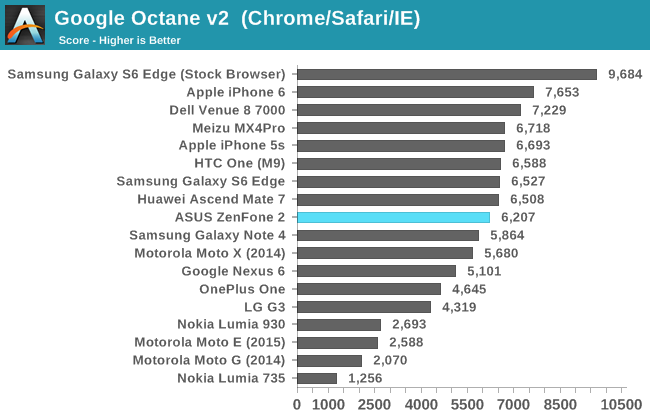
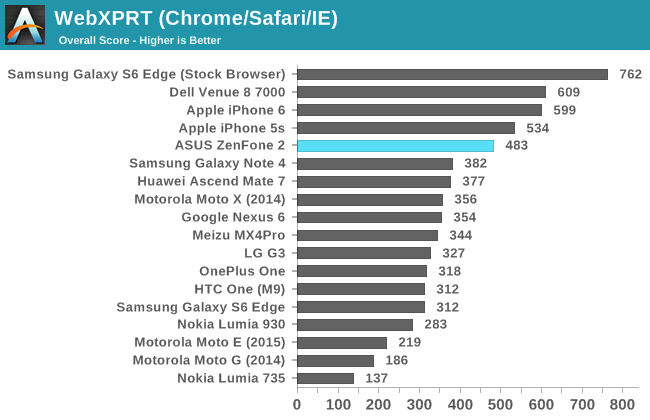
In our web browsing tests the ZenFone 2 performs very well. In the case of Kraken, it does roughly as well as the Venue 8 7000 which uses the same Z3580 SoC. Performance tends to fall behind the Venue 8 in our longer tests like Octane and WebXPRT. I don't have the Venue 8 anymore, but it's a safe bet that this is due to the larger aluminum chassis of the Venue 8 being able to manage heat better in order to keep the clock speeds on the CPU higher during the course of the test.
While the ZenFone 2 isn't quite as fast as a tablet using the same SoC, it's much faster than most of the other devices that we've tested. In general it ends up being a bit slower than the iPhone 5s and the iPhone 6, and of course it loses to the Galaxy S6 using Samsung's browser by an enormous margin in every case. However, a good portion the phones that sit below it are very expensive flagship phones like the Nexus 6, LG G3, and the Galaxy Note 4 which is very impressive for a $300 smartphone.
The next test is Basemark OS II which tests the performance of a device's CPU, GPU, RAM, and NAND.
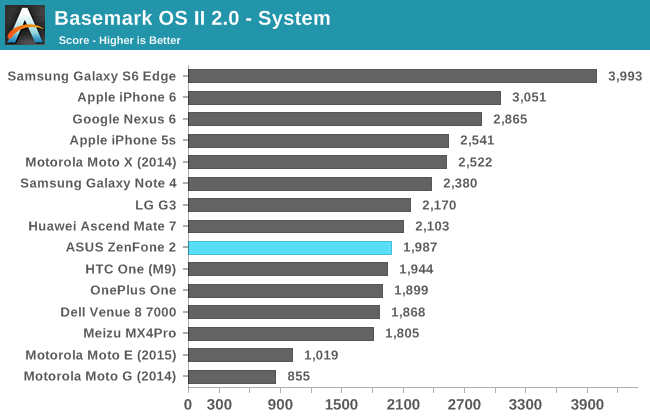
The system sub test performs integer and floating point operations, and also performs some tests like XML parsing. This makes it primarily a test of the device's CPU and RAM. I'm actually somewhat surprised by the ZenFone's performance in this test. By no means is it bad, but I had forgotten that the Venue 8 also struggled to match Snapdragon 801 smartphones in this test.
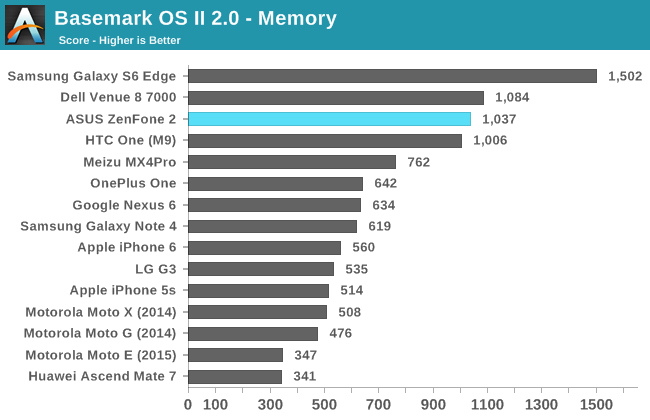
The Basemark OS II memory sub test has a somewhat vague name. While one might expect it to be a test of the device’s RAM, it’s actually a flash storage test. In it we see one of the highest scores of the smartphones we’ve tested, with only the Dell Venue 8 tablet and the Galaxy S6 with its UFS memory achieving higher scores.
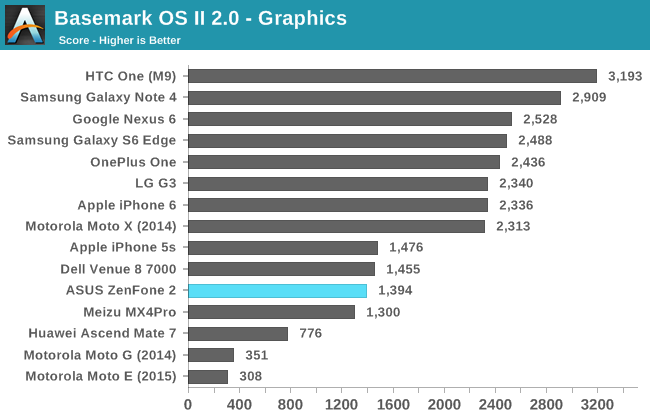
The result in the graphics test is definitely on the lower end of our results, but it’s not unexpected. Both the Venue 8 7000 and the iPhone 5s achieve similar scores, and all three devices use the same G6430 GPU (albeit with lower clock speeds on the iPhone). Even though the ZenFone 2 doesn’t perform as well as the expensive flagship smartphones, it’s far ahead of budget devices like the Moto G. Since both the Z3560 and Z3580 based ZenFone 2 models use the same 533MHz PowerVR G6430 this result should be roughly the same on the $199 model as it is on this $299 model.

The last sub test is the web test. This test focuses on a device’s ability to handle web page rendering, with a focus on HTML5 and CSS rather than Javascript code. In this test we see the ZenFone 2 amongst a large group of devices that includes the HTC One (M9), the Nexus 6, and the Moto X. To see the same level of performance as Snapdragon 805 and 810 devices is very impressive.
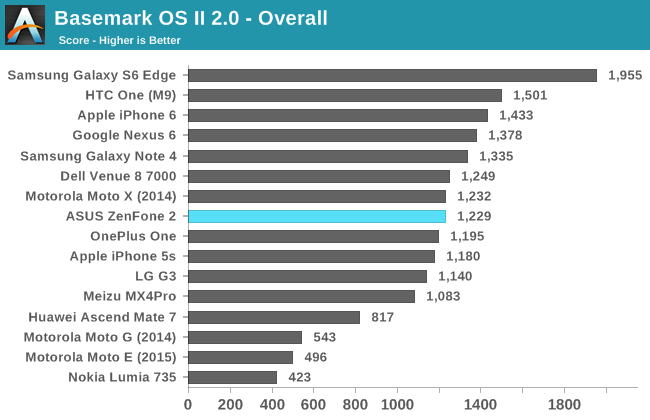
The overall score for BaseMark OS II takes into the account the scores of the various sub tests to generate a final score. In this test we again see the ZenFone 2 around the middle of the pack, with a score that is similar to that of Snapdragon 801 based devices. This is a very good result for a smartphone that costs so little, although the OnePlus One also achieves similar performance at roughly the same price as the $299 model of the ZenFone we are testing.
Our last general performance benchmark is PCMark. This is a relatively new addition to our testing workflow, and it focuses on race to sleep scenarios that reflect the type of usage a device will see in the real world. The tests range from Javascript performance, to playing and seeking in videos, to editing photos.

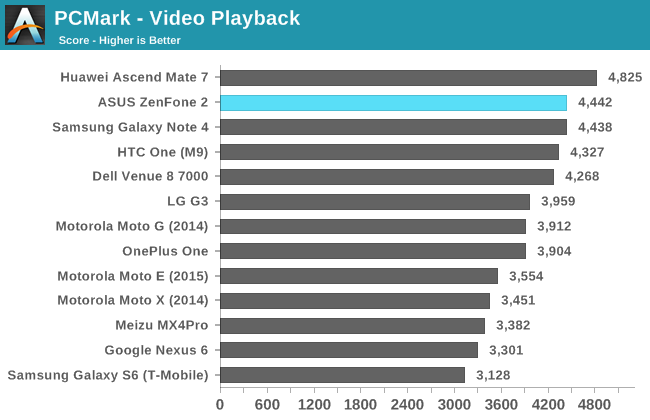
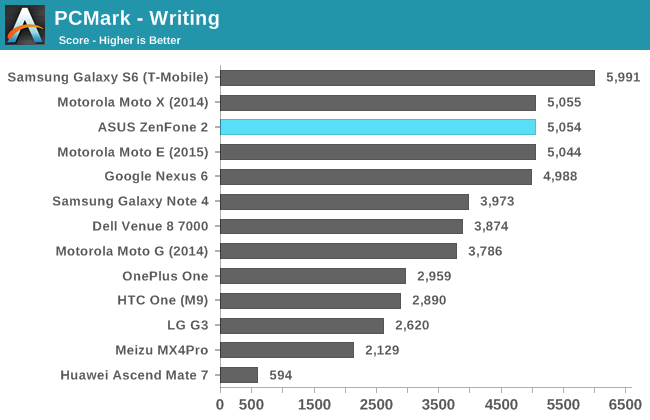
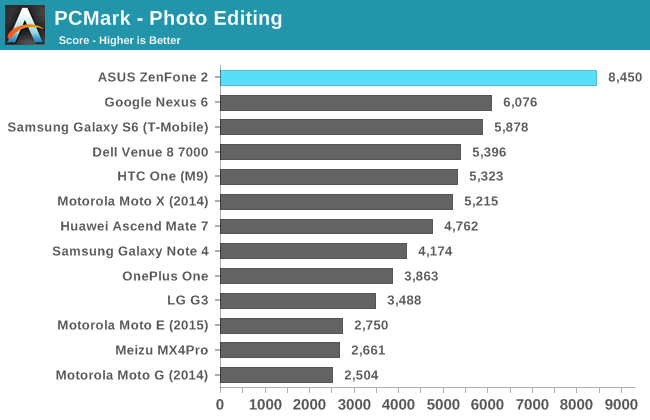
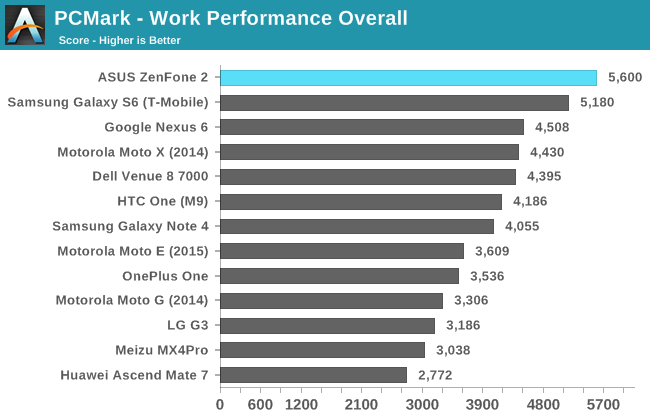
In all of the PCMark sub tests the ZenFone 2 performs extremely well. It’s always at or very close to the top result, and only really loses by a large margin to the Galaxy S6 in the tests that it isn’t right near the top for. The one exception is the photo editing test where it beats every other device by an enormous amount. This score is what carries it to the top position when it comes to the overall score.
I think it’s a bit unfair to say that the ZenFone is the fastest device when it only comes first in a single test, but even without considering the photo editing test it’s clear that the ZenFone 2 offers great performance. Even more amazing is that at times it can trade blows with flagship phones that cost much more than it does. Perhaps due to the fact that it's the only x86 Silvermont-based phone in our benchmarks its relative performance can bounce around versus the competition, but on average it comes rather close to delivering the kind of CPU performance we've seen from the flagship phones over the past year.










147 Comments
View All Comments
piaw - Tuesday, May 26, 2015 - link
I don't want Windows Phone on this, I want full on Windows 10 with a telephony app! This will eliminate the "app gap" (sure, might have to use desktop mode, but for something like say, Garmin Express, I don't need to even see the UI after installation). With 4GB of RAM, this will outrun any number of existing full Windows tablets!mkozakewich - Tuesday, May 26, 2015 - link
If needed, it's also possible to have Windows and Android on at the same time with a button on each desktop to switch to the other OS.(Unless MS was brilliant and enabled Continuum to switch from a Windows Phone UI to a Desktop UI?)
darkich - Tuesday, May 26, 2015 - link
The only possible reason why this is a $300 device, is the giveaway from Intel.Their most advanced Atom yet couldn't be sold for its real price and the fact that it can only compete with old 28nm and 20nm ARM chips explains why is that the case.
Speedfriend - Tuesday, May 26, 2015 - link
This isn't the most advanced Atom yet, it is the last generation phone SOC.Intel doesn't give away any chips, it helps OEMs use intel SOCs by contributing to the higher bill of materials that using an Intel SOC entailed. As it adds features to its SOC, the contra revenue will go down.
SunLord - Tuesday, May 26, 2015 - link
Technically this is the current generation phone SOC as they've not launched an airmont based phone SOC yetmenting - Tuesday, May 26, 2015 - link
The CPU being free or not won't make more than $50 difference though....lefty2 - Tuesday, May 26, 2015 - link
The ZenFone is cheap because of Intel's contra revenue scheme. Basically, Intel sells the SoC to Asus for $0.tipoo - Tuesday, May 26, 2015 - link
I read Asus ends up paying 5 dollars per chip rather than the 30+ some SoCs sell at, but yeah, close enough.CrazyElf - Tuesday, May 26, 2015 - link
For it's price, it's not a bad phone to be honest.I'd love to see what Asus can do in future generations and what a flagship that can rival high end phones like the Galaxy Note X would be able to pull off.
Equally interesting will be what future Intel SOCs do. I would like to see an even bigger GPU loaded onto the phone.
UltraWide - Tuesday, May 26, 2015 - link
What good is all this performance if the phone has ran out of batteries and you can't use it?